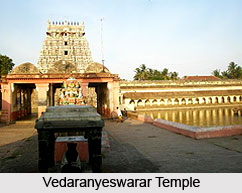 History of Vedarnyam shows the magnificent artistic beauty of Chola temples. History of Vedaranyam is found from the inscriptions in Vedaranyeswarar Temple. This is one of the most important temples in this region. The inscriptions date from the reign of Aditya Chola, Rajaraja Chola I, Rajendra Chola I and Kulothunga Chola I representing various grants to the temple. Paranjothi Munivar, a 13th-century saint, who wrote the book Thiruvilaiyadal Puranam, was born at Vedaranyam.
History of Vedarnyam shows the magnificent artistic beauty of Chola temples. History of Vedaranyam is found from the inscriptions in Vedaranyeswarar Temple. This is one of the most important temples in this region. The inscriptions date from the reign of Aditya Chola, Rajaraja Chola I, Rajendra Chola I and Kulothunga Chola I representing various grants to the temple. Paranjothi Munivar, a 13th-century saint, who wrote the book Thiruvilaiyadal Puranam, was born at Vedaranyam.
History of Vedarnyam also shows that from the time of ancient time, this place was the centre of Shaiva cult. Vedaranyam was the part of glorious Chola Empire. During the reign of Kulothunga Chola I (1070-1120), Vedarnyam flourished as the Shaiva cult. After the fall of Cholas during the reign of Rajendra Chola II in the 13th century, the Chola region was caught under a power struggle between Pandyas and Hoysalas.
The royal patronage of Pandyas and Hoysalas continued to Vedaranyeswarar Temple during the rule of the Nayaks. The "Negapatam" region was captured by troops of French East India Company lead by Lally (1702-66) in 1759.
Tanjore district was annexed by British forces after the French failed to subdue the king of Tanjore. During the period of British East India Company, Vedaranyam was part of Thiruthuraipoondi Taluk under Tanjore district. The Salt from Vedaranyam was transported to Nagapttinam port through a 51 km long canal.
In the modern days, Mahatma Gandhi launched the Dandi March along India`s west coast to protest against the sales tax levied on salt extraction. His close associate and disciple C. Rajagopalachari carried out a salt march in parallel, on the east coast starting from Tiruchirappalli in Vedaranyam. C. Rajagopalachari and his group like the freedom fighter Sardar Vedaratnam, started the salt march from Tiruchirappalli, in Madras Presidency, which is now part of Tamil Nadu in the independent India to the coast of the town of Vedaranyam. After making illegal salt extraction there on 30th April 1930, C. Rajagopalachari and his group were arrested by the police of British Government in India. After India`s independence, Vedaranyam, the town of historical and religious importance continued to be a part of Thanjavur district until 1991. Later, this place became part of the newly created Nagapattinam district.



















